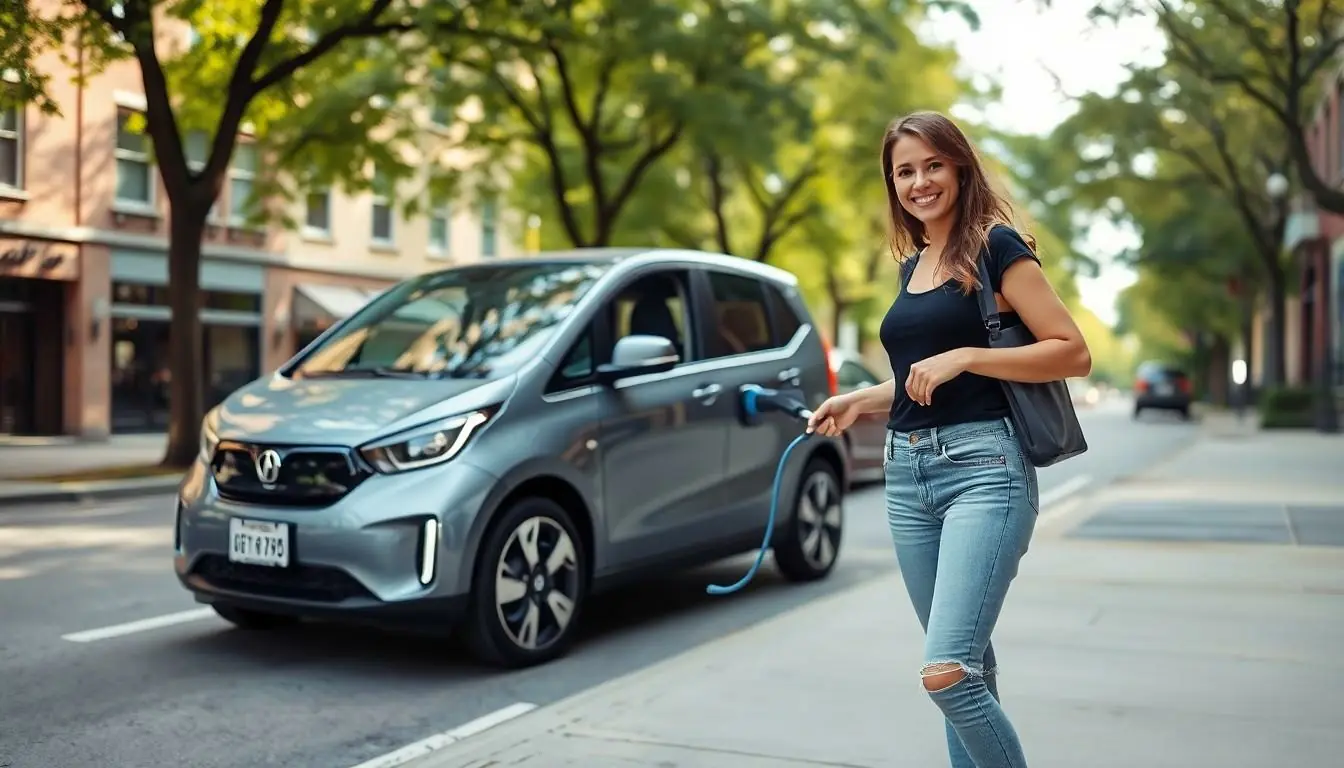In a world where gas prices soar and traffic jams feel like a second job, neighborhood electric vehicles (NEVs) are the quirky little superheroes we didn’t know we needed. Picture this: zipping around your community, dodging potholes and nosy neighbors, all while reducing your carbon footprint. It’s like driving a golf cart but with a lot more style and zero guilt.
Table of Contents
ToggleOverview of Neighborhood Electric Vehicles
Neighborhood electric vehicles (NEVs) provide an efficient option for short-distance travel. Designed primarily for urban environments, these vehicles enable easy navigation through narrow streets. Many users appreciate their compact size, which enhances parking possibilities.
Environmental consciousness drives the popularity of NEVs. By using electricity instead of gasoline, they reduce harmful emissions significantly. Battery capacities of most NEVs typically allow for a range of up to 40 miles on a single charge, suitable for running local errands and commuting within neighborhoods.
Regulations support NEV usage in specific areas. Various states allow NEVs to operate on roads with speed limits of 35 miles per hour or less. Many communities have also designated specific routes for NEV operation, making these vehicles more accessible to residents.
Battery types found in NEVs include lithium-ion and lead-acid options. Lithium-ion batteries offer advantages like lightweight design and longer lifespan compared to traditional lead-acid batteries. Charging times vary; while some models recharge in as little as 4 hours, others may require a full overnight charge.
Safety features continue to evolve, ensuring their reliability. NEVs often include seat belts, headlights, and turn signals, similar to traditional vehicles. Manufacturers also implement additional safety protocols to meet regulatory standards, enhancing peace of mind for users.
Affordability represents another attraction of NEVs. Prices typically range from $7,000 to $20,000, providing a budget-friendly alternative to conventional cars. Tax incentives and rebates further encourage purchases, making NEVs an appealing choice for many consumers.
Benefits of Neighborhood Electric Vehicles

Neighborhood electric vehicles offer various advantages, making them an attractive option for many consumers.
Environmental Impact
Reducing harmful emissions stands out as a primary benefit. NEVs use electricity instead of gasoline, significantly lowering an individual’s carbon footprint. These vehicles contribute to improved air quality in urban areas where traffic congestion persists. An impressive feature includes a range of up to 40 miles on a single charge, making them ideal for local trips. By driving NEVs, individuals support a shift toward eco-friendly transportation solutions, essential for combating climate change.
Cost Savings
Affordability plays a crucial role in the appeal of neighborhood electric vehicles. Prices typically range from $7,000 to $20,000, considerably lower than many traditional vehicles. Tax incentives and rebates further enhance financial benefits, reducing overall costs for buyers. Additionally, the electric nature of NEVs minimizes fuel expenses, allowing for significant savings over time. With maintenance costs lower than those associated with gasoline-powered cars, owning an NEV becomes an economically sound decision for short-distance travel.
Popular Models of Neighborhood Electric Vehicles
Many neighborhood electric vehicles (NEVs) attract attention for their efficiency and eco-friendliness. Below are two popular models offering distinct features and functionality.
Model 1: GEM e2
GEM e2 stands out as a leading choice in the NEV market. This model features a compact design, accommodating up to four passengers. With a top speed of 25 miles per hour, it excels in urban environments. Its range of approximately 30 miles on a single charge makes it ideal for local errands. Equipped with a 72V battery, the GEM e2 recharges in about 8 hours, providing convenience for daily use. Safety features include seat belts, turn signals, and headlights, ensuring compliance with local regulations. Additionally, the price typically ranges from $12,000 to $15,000, making it an accessible option for consumers.
Model 2: Calterm NEV
Calterm NEV offers versatility and style, appealing to a wide range of consumers. This model supports two to four passengers, making it suitable for small families or groups. With a maximum speed of 20 miles per hour, it provides a smooth ride on neighborhood streets. A battery range of approximately 40 miles ensures users can run errands easily. Charging the Calterm NEV takes around 6 hours, providing ample time for overnight recharges. Built-in safety features, such as a reinforced frame and energy-efficient lighting, enhance safety. Pricing starts around $8,000, providing an economical option for eco-conscious buyers.
Challenges in Adoption
Adoption of neighborhood electric vehicles (NEVs) faces several significant challenges. Infrastructure limitations impede widespread usage.
Infrastructure Limitations
Charging stations often lack availability in many communities. Existing networks may not support the growing demand for electric vehicles. Urban areas sometimes feature limited access to charging points, which poses inconvenience for NEV users. Communities without adequate infrastructure experience slower adoption rates. Enhancing charging networks in residential and commercial areas can facilitate adoption, making NEVs more practical for daily use. A robust infrastructure encourages consumers to consider electric options due to increased convenience and reliability.
Regulatory Hurdles
Regulatory hurdles also contribute to challenges in NEV adoption. Many states impose specific regulations, which may restrict NEV operation on highways or other major roads. Confusion surrounding regulations can deter potential buyers from making a purchase. Each state implements different rules for NEV classifications, leading to inconsistencies that complicate ownership. Creating a unified framework for NEV regulations can simplify the process for prospective owners and promote wider acceptance. Streamlined regulations may help enhance confidence in NEV usage.
Future Trends in Neighborhood Electric Vehicles
Advancements in technology shape the future of neighborhood electric vehicles (NEVs). Innovations in battery technology promise increased efficiency and longer ranges for NEVs. For example, solid-state batteries may soon replace traditional lithium-ion options, offering higher energy density and faster charging times. Enhanced safety features are also emerging, ensuring improved protection for drivers and passengers.
Urban planning focuses on accommodating NEVs within city infrastructure. More cities are incorporating dedicated lanes and parking spots for electric vehicles. Smart city initiatives integrate charging stations into urban designs, making access more convenient. In addition, collaborations between manufacturers and local governments aim to streamline regulations and expand operational areas for NEVs.
Consumer preferences are shifting toward eco-friendly transportation solutions. Public awareness campaigns highlight the environmental benefits of using NEVs. As concerns about climate change grow, NEVs become an attractive option for short-distance travel. Incentives, including limited-time tax credits, encourage consumers to consider these vehicles as viable alternatives to gasoline-powered cars.
Market growth boosts NEV adoption rates across various demographics. Manufacturers are exploring partnerships with ride-sharing and delivery services. The demand for versatile vehicles that can serve multiple purposes increases, leading to the development of more models designed for varying consumer needs.
Lastly, global trends reveal rising interest in sustainable transportation options. Countries around the world are implementing policies that promote electric vehicle usage. Regulations incentivize manufacturers to invest in electric mobility solutions. The transition toward NEVs signifies a larger commitment to reducing carbon emissions and improving quality of life in urban areas.
Neighborhood electric vehicles are transforming urban commuting by offering an eco-friendly and cost-effective alternative to traditional cars. Their compact design and ease of use make them ideal for short trips while significantly lowering carbon emissions. As cities adapt to support NEVs with better infrastructure and regulations, their popularity is likely to grow.
The advancements in battery technology and increasing consumer awareness further enhance their appeal. With a focus on sustainability and practicality, NEVs are poised to play a crucial role in the future of urban transportation, contributing to cleaner air and improved quality of life in communities.





